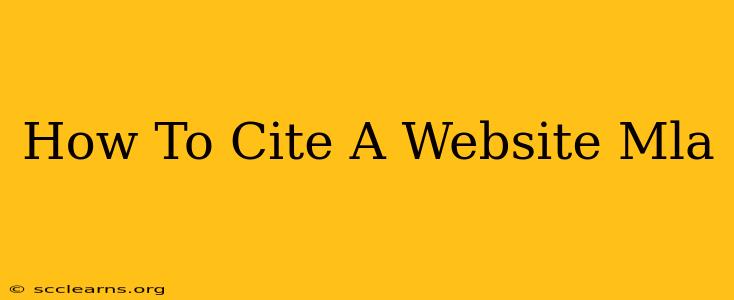Properly citing sources is crucial for academic integrity. When you use information from a website in your MLA-formatted paper, you need to give credit to the original author(s) and the source. This guide will walk you through the process of creating accurate and complete MLA website citations.
Understanding MLA Website Citation Basics
The MLA (Modern Language Association) style emphasizes brevity and clarity. A typical MLA website citation includes the following core elements:
- Author: The name of the person or organization responsible for the content. If no author is listed, use the website name or article title instead.
- Article Title: The title of the specific web page or article you used. Capitalize the first letter of important words (title case).
- Website Title: The name of the website itself. Italicize this.
- Publisher: Often the same as the website name, but sometimes different (e.g., a news article on a website).
- Publication Date: The date the webpage or article was published (or last updated).
- URL: The website address. Place this within angle brackets.
- Date Accessed: The date you accessed the information on the website.
Example MLA Website Citations
Let's look at some examples to illustrate the different scenarios you might encounter.
Example 1: Website with an Author
Author's Last Name, Author's First Name. "Article Title." Website Title, Publisher, Publication Date, URL. Accessed Day Month Year.
For example:
Smith, John. "The Impact of Social Media on Politics." The Daily News, ABC Publishing, 15 Oct. 2023, www.dailynews.com/socialmediapolitcs. Accessed 20 Oct. 2023.
Example 2: Website with No Author
If there's no author listed, begin with the article title:
"Article Title." Website Title, Publisher, Publication Date, URL. Accessed Day Month Year.
For instance:
"Climate Change and its Effects." National Geographic, National Geographic Society, 10 Nov. 2023, www.nationalgeographic.com/climatechange. Accessed 22 Nov. 2023.
Example 3: Website with a Corporate Author
When a corporation or organization is the author:
Organization Name. "Article Title." Website Title, Publisher, Publication Date, URL. Accessed Day Month Year.
Example:
World Health Organization. "Coronavirus Disease (COVID-19) Advice for Public." WHO, World Health Organization, 24 Dec. 2023, www.who.int/covid-19. Accessed 25 Dec. 2023.
Tips for Accurate Website Citations
- Double-check your information: Carefully verify all details like author names, dates, and URLs before finalizing your citation.
- Use consistent formatting: Maintain consistent capitalization, punctuation, and italics throughout your citations.
- Use the MLA Handbook: Refer to the most current edition of the MLA Handbook for the latest guidelines. It's the definitive resource on MLA style.
- Seek help if needed: If you have difficulties, don't hesitate to consult your instructor or a librarian. They can provide assistance and ensure your citations are accurate.
Avoiding Common Mistakes
- Incorrect date formats: Always use the correct MLA date format (Day Month Year).
- Missing information: Don't leave out any essential elements. A complete citation is crucial.
- Improper capitalization: Pay close attention to title case capitalization for article and website titles.
- Inconsistent formatting: Maintain consistency in font styles and punctuation.
By following this guide, you can accurately cite websites in your MLA-formatted papers, demonstrating responsible scholarship and avoiding plagiarism. Remember that accuracy and consistency are paramount in academic writing.

